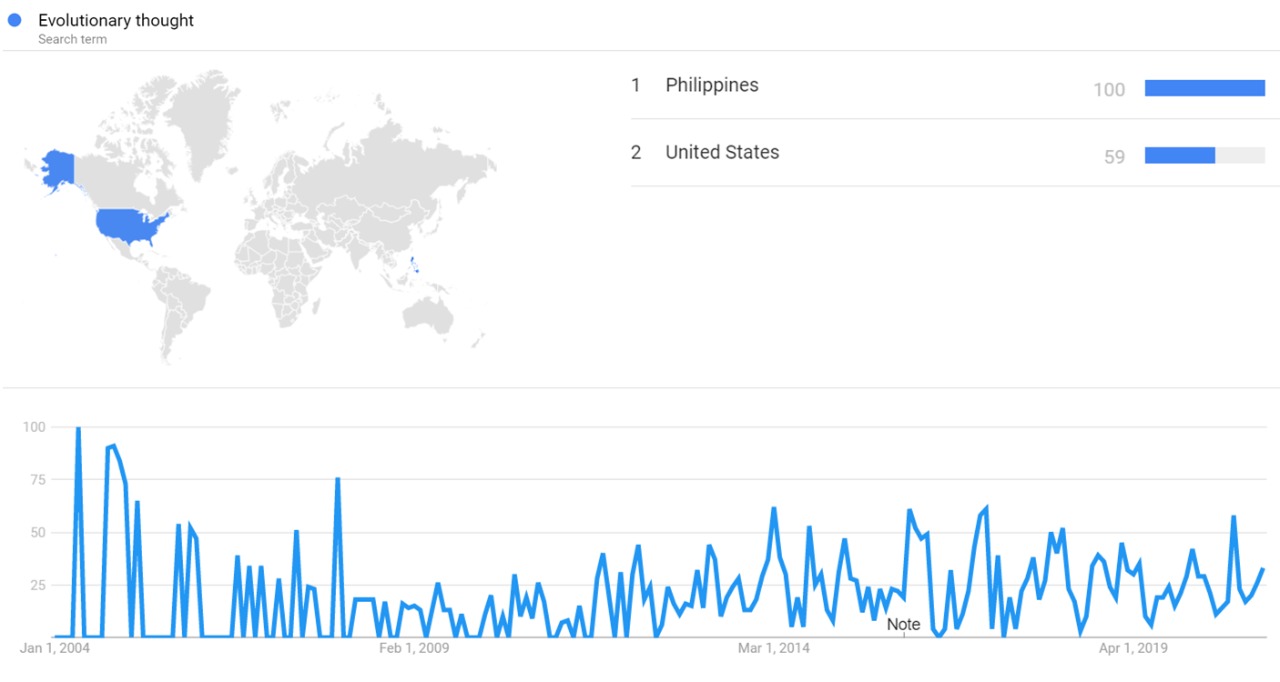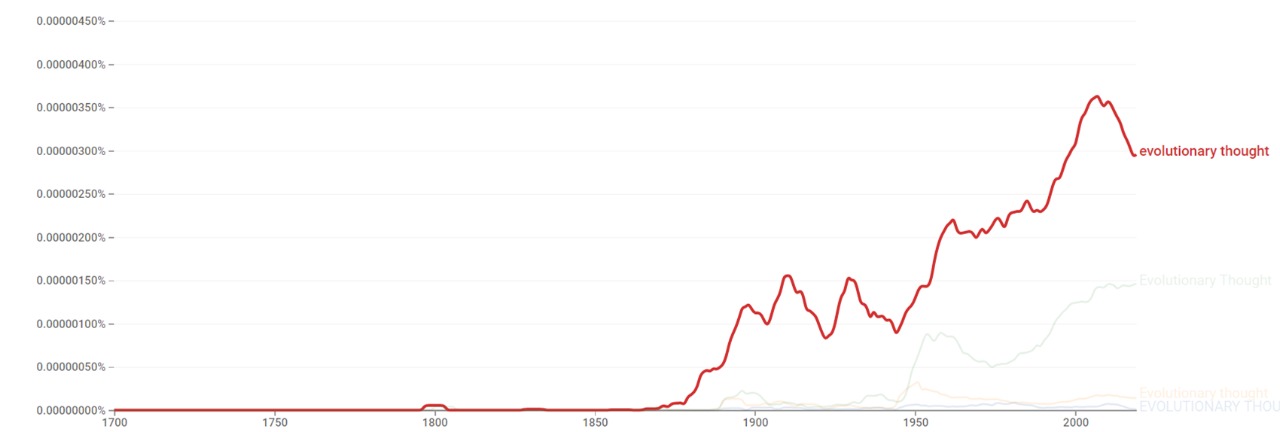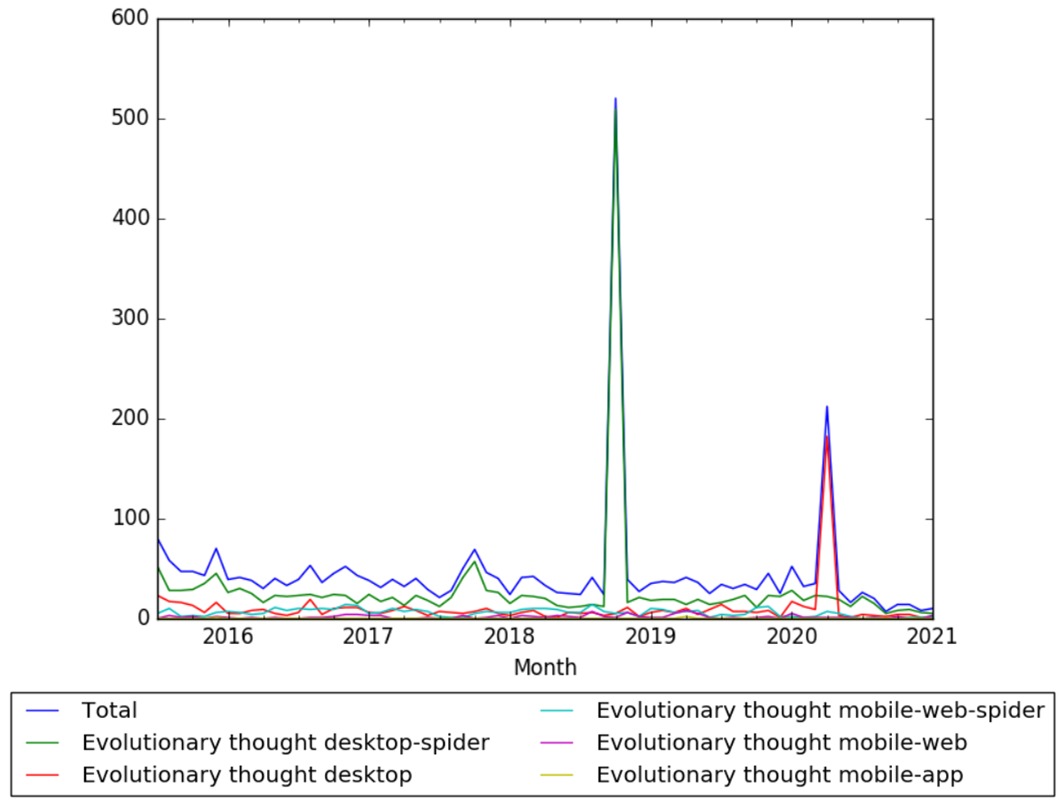Timeline of evolutionary thought
From Timelines
This is a timeline of evolutionary thought.
Contents
Big picture
| Time period | Development summary | More details |
|---|---|---|
| 1880s–1920s | The eclipse of Darwinism takes place. |
Visual data
Google trends
The image below shows Google Trends data for Evolutionary thought (Search Term), from January 2004 to January 2021, when the screenshot was taken. Interest is also ranked by country and displayed on world map.[1]
Google Ngram Viewer
The chart below shows Google Ngram Viewer data for Evolutionary thought, from 1700 to 2019.[2]
Wikipedia Views
The chart below shows pageviews of the English Wikipedia article History of evolutionary thought, on desktop, mobile-web, desktop-spider, mobile-web-spider and mobile app, from July 2015 to January 2021.[3]
Full timeline
| Year | Month and date | Event type | Details |
|---|---|---|---|
| 1859 | Publication | Charles Darwin's On the Origin of Species is published.[4] | |
| mid-1880s | Weismann develops his ideas about heredity and development around this time.[4] | ||
| 1896 | James Mark Baldwin's paper "A New Factor in Evolution" is published. The paper describes what would later be called the Baldwin effect. | ||
| 1900 | "now regarded as the birthdate of the discipline" of genetics.[4]:24 | ||
| 1930s | The Modern Synthesis takes place. | ||
| 1940s | C. H. Waddington coins the concept and term "canalization".[5][6] | ||
| 1953 | Watson and Crick describe the structure of DNA.[4]:30 | ||
| 1958 | Francis Crick describes the "central dogma" of molecular biology.[4]:31 | ||
| late 1950s – 1960s | Tracy Sonneborn and colleagues discover a form of structural inheritance in the cilia of Paramecium.[4]:119 | ||
| 1960s | Helen Crouse's studies on the chromosomal behavior of Sciara are conducted during this period.[4]:137 | ||
| 1960s–1970s | "some of the processes that enable the information in a sequence of DNA to be converted into the polypeptide chains of proteins were worked out".[4]:50 | ||
| 1970s | Stanley B. Prusiner and colleagues begin their research on prions. | ||
| 1972 | Eldredge and Gould's paper on punctuated equilibrium is published. | ||
| 1973 | Leigh Van Valen proposes the Red Queen hypothesis. | ||
| mid-1970s | Until this period, "the existence of epigenetic inheritance was barely recognized".[4]:111 | ||
| 1975 | Robin Holiday and John Pugh in Britain as well as Arthur Riggs in the United States independently suggest a mechanism of transmitting gene activity or inactivity to future cell generations.[4]:111–112 | ||
| 1976 | Publication | Richard Dawkins's The Selfish Gene is published.[4]:37 | |
| 1988 | John Cairns and his colleagues publish a paper in Nature arguing that mutations are not entirely random.[4]:79–80 | ||
| late 1990s | RNA interference (RNAi) is discovered.[4]:130 | ||
| 2010 | Massimo Pigliucci's book, Evolution: The Extended Synthesis, is published. The book relaunches the idea of an extended synthesis. | ||
| 2011 | Publication | Yuval Noah Harari's Sapiens: A Brief History of Humankind is published.[7] |
Meta information on the timeline
How the timeline was built
What the timeline is still missing
Timeline update strategy
See also
External links
Timeline of the evolution of life
References
- ↑ "Evolutionary thought". Google Trends. Retrieved 16 February 2021.
- ↑ "Evolutionary thought". books.google.com. Retrieved 20 February 2021.
- ↑ "Evolutionary thought". wikipediaviews.org. Retrieved 21 February 2021.
- ↑ 4.00 4.01 4.02 4.03 4.04 4.05 4.06 4.07 4.08 4.09 4.10 4.11 4.12 Jablonka, Eva; Lamb, Marion J. (2014). Evolution in Four Dimensions: Genetic, Epigenetic, Behavioral, and Symbolic Variation in the History of Life (Revised Edition). Massachusetts Institute of Technology.
- ↑ Flatt T. "The evolutionary genetics of canalization.". PubMed - NCBI. Retrieved June 7, 2017.
In the 1940s, Conrad Hal Waddington coined the concept and term "canalization" to describe the robustness of phenotypes to perturbation
- ↑ Eshel, Ilan; Matessi, Carlo (August 1, 1998). "Canalization, Genetic Assimilation and Preadaptation: A Quantitative Genetic Model". Genetics. Retrieved June 7, 2017.
The peculiar pattern of interaction between genetic and environmental variation that underlies the expression of crossveins, and of other traits that can be similarly subject to assimilation, was described by Waddington using the concept of genetic canalization (Waddington 1940).
- ↑ "Obama recommends book by Israeli author Yuval N. Harari". ynetnews.com. Retrieved 3 December 2017.


